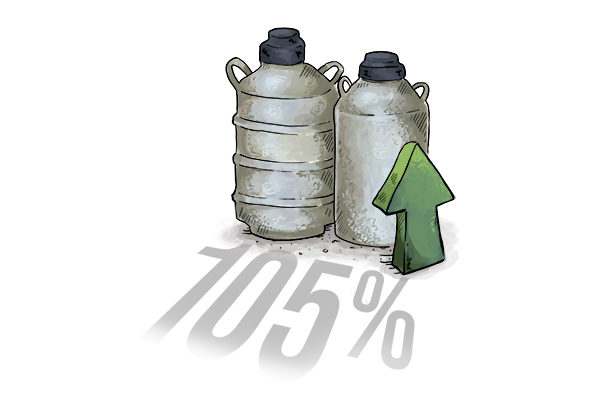There’s no denying the numbers – frozen beef semen sales are on the rise in a big way. Not only has this influenced dairy producers, it’s also having an impact on the marketing of specific breeds and their associations. Beef sires in A.I. service have grown exponentially, especially since 2013. Seedstock producers, breed associations and stud companies have all responded to new opportunities in recent years.
While beef-on-dairy breeding is largely responsible for market growth, equally interesting is how different breeds have grown, with some moving faster than others.
Not just any beef stud will fit the unique needs of dairy cattle. This has resulted in the uptick of certain breeds and the development of specialty indexes.
An overview of today’s market
From 2013 to 2019, total beef semen sales rose nearly 105%. Simmentals led by total increase, up by an impressive 296%, followed by Limousin at 251%.
By volume, Angus still leads the pack with an increase nearing 97%, having sold 4,411,231 units in 2019.
While Angus has certainly paid heed to the growing dairy market – the American Angus Association released not one but two different dollar indexes for Holsteins and Jerseys – a big part of their lead is premiums associated with black hides.
“The expectation from a buyer is that every time they use an Angus bull or a homozygous black SimAngus, they are going to get a solid black calf, but it doesn’t always work that way,” explains Brian House, beef program vice president for Select Sires.
While Angus has certainly made its mark in the beef world, Continental and composite breeds are rapidly increasingly in popularity.
“The data shows while Angus is still the volume player, they aren’t increasing at the same rate as the number of the Continental and Continental hybrid populations,” explains Chip Kemp, director of International Genetics Solutions. “Charolais, Limousin and Simmental all have roughly a 300 percent increase in semen from 2013 to 2019.”
But the change across breeds is by no means uniform.
The difference, Kemp notes, is volume among the three breeds. For example, while Charolais has seen a significant increase, by total numbers they are still less than half of what Limousins were in 2019 and less than a third of Simmentals.
Also noteworthy is the way semen sales have grown in the international marketplace – especially when it comes to Latin America. In big beef-producing countries, such as Brazil, the Nelore breed dominates, though breeders are adding value with crossbreeding.
“They use our U.S. genetics and high-performance bulls, and are able to generate more pounds of product with their breeding programs,” House says.
This is part of what has contributed to the massive Angus sales, as Brazil also favors the black-hided animals.
Why the difference in breeds?
As in the international market, black hides, polled genetics and overall popularity are big reasons British breeds, particularly Angus, lead the beef-on-dairy space. However, Continental breeds are able to contribute greater muscle.
In addition, Kemp notes Continental breeds bring an advantage to large-framed dairy breeds with their moderate size while still not giving up muscling or shape.
“Overall, you’re seeing the trend in Continental-influence cattle on dairies are very strong,” he says.
Casey Kelley of Running Creek Ranch in Elizabeth, Colorado, reports they have had dairy interest in their registered Limousin genetics since the mid-1990s.
“Initial demand was for Limousin semen suitable for use in yearling heifers of various dairy breeds,” he says. “The market has since expanded to include as much as 80 percent of the breeding females on an individual dairy operation.”
Taking some of the best of both worlds, House also notes that hybrids, in particular the SimAngus, are a very popular choice among his dairy customers.
Breed association influence
With a growing demand for specific traits in bulls used by dairies, some of the breed associations have worked to capitalize on this market.
“Beef-on-dairy selection is very complex and has been a moving target,” House explains. “But from the back to the front, everything for the dairy customer is data-driven.”
In response, associations have invested time and research to create indexes specifically for dairy buyers. They are the result of input from meatpackers, dairy producers and industry professionals.
For example, in 2019, the American Simmental Association developed a dollar index for Simmental-on-Holstein matings. This index focuses on improving ribeye shape, muscle mass and reducing carcass size. These are all areas where straight-bred Holsteins are notorious for being docked.
In a similar way, the Angus Association’s Jersey index addresses the needs of a smaller-framed animal while also increasing muscle mass.
Seedstock response
Operations like Running Creek Ranch are routinely serving dairy customers along with their beef ones.
“Beef seedstock producers that emphasize calving ease coupled with growth and carcass quality have an opportunity to capitalize on the growing demand throughout the dairy sector,” says Kelley.
Experience, he believes, has shown excellent breed complementarity of Limousin genetics in dairy. Kelley also points out beef-on-dairy progeny can seamlessly qualify for natural beef or non-hormone-treated programs to satisfy export markets.
Something else to keep an eye on are opportunities for beef embryos in the dairy market.
“I think there’s much reason for that conversation,” says Kemp. “There’s no question if we compare a straight-bred beef animal to a straight-bred dairy animal, we’re going to have tremendous terminal value.”
However, he argues much volatility has been added into the beef-on-dairy market. This was created by lots of leftover Angus semen being sold by companies to dairies. He points out no straight-breed beef animal, until some recent selection, has been designed to mitigate the terminal challenges Holsteins present.
“Composite cattle bear the benefit of some of the terminal merits of Angus, but they also bring some of the terminal benefits of the Continental, and they just balance out a Holstein.”
The top 25% of these bulls are outstanding, but they decrease in quality down the line. Feeders cannot accept variability in these animals, Kemp explains. They cannot afford to pay premiums for beef-on-dairy calves who may have a lot of volatility and variation at the packer.
“What we’re seeing is a much more sophisticated approach to genetic awareness,” he continues, “where dairy folks are using the same serious genetic knowledge they already use on the dairy space as they make selections for their beef bulls.”
As such, he expects the Continental and composite sire influence to continue in the dairy space.









